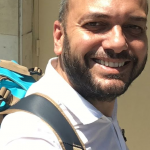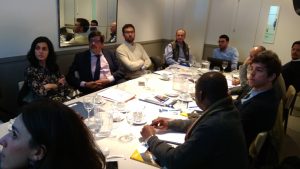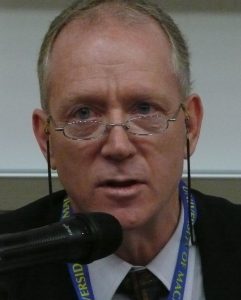
Contents
Letter from the President, Jeremiah Alberg
Musings from the Executive Secretary, Martha Reineke
Editor’s Column, Curtis Gruenler
COV&R Annual Meeting 2019 at Innsbruck
Theology and Peace Annual Conference
COV&R Sessions at the American Academy of Religion
COV&R Annual Meeting at Purdue University, Lafayette, Indiana, USA
Letter from Madrid, David García-Ramos Gallego
Sam J. Miller, Blackfish City, reviewed by Curtis Gruenler
Bibliography XLVI, Dietmar Regensburger
Letter from the President
Jeremiah Alberg
International Christian University
This will be my last letter as President to you, the members of the Colloquium. I want to thank all of you for the privilege of serving you in this capacity for the last four years. I wish to especially thank the board members both past and present who helped with their expertise and advice. And I wish to especially thank Martha Reineke for her unstinting work as Executive Secretary. All of you made the task not only lighter but more enjoyable.
The most important event for COV&R during my terms of office was, of course, the death of René Girard, the inspiration for the work that COV&R carries on. In light of that, as my final message, I would like to simply adapt the tribute that I gave to René at the Melbourne Conference in 2016. So here it is:
I am grateful for this opportunity to give tribute to the memory of René Girard. I will begin by mentioning that my daughters and I will be visiting Martha in a couple of weeks. I will tell her about this year’s conference and especially about this tribute. I know it will be a comfort to her.
René Girard was not the founder of the Colloquium on Violence and Religion, he was not even one of the founders, and yet COV&R owes its existence to him. There may be a René Girard Society at some point in the future but that is not exactly what COV&R was nor is. It is a Colloquium, a discussion, a discussion among friends. So from the point of view of COV&R, which I represent tonight, if we ask, who was René Girard, the answer is that he is the one with whom we spoke, the one to whom we listened, the one we wanted to hear. For years, the high point of the COV&R Conference was the talk by René. That is what we desired to hear.
And so we come, as we always do with René, to the notion of desire. What makes one want to hear someone, to want to listen to him. As students of mimetic theory, we know: we want to hear because others wanted to hear. Gil Bailie longed to hear René Girard, and so I, in listening to Gil’s tapes, began to want to hear René, and due to my desire Richard Schenk began to want to hear. So without a false search for a non-existent origin, I think that we can say that our desire to listen goes back to Rene’s own desire to listen. We were imitating him.
René himself longed to hear something. This longing provoked his departure from France and his sojourn in the United States. There he began to hear what he desired to hear in great literature, particularly the literature of France. He also heard quite clearly in works of Dostoevsky. And this led him to hear, with a clarity that is rare in this world, the voice of Christ, the living Word.
For most of us all of this is precisely what made us so eager to hear his voice, to listen to his talks, to engage him in conversation, to receive his encouragement in our work. We too long to hear, not so much René Girard, but to hear what he heard. We would like to be the other villagers of the Samaritan women in John’s Gospel. “We no longer believe just because of what you said; now we have heard for ourselves, and we know that this man really is the Savior of the world.”
The living voice of René has been silenced. The French accented English, the laughter is now gone. We are right to be sad. But it is ultimately his desire to hear, a desire that has affected us, that makes us miss hearing him, but also makes us want to listen to each other, to the voices of literature, and to hear the word of God. This desire lives on in us. It constitutes the very identity of this group and so we are deeply, deeply grateful for his life.
And I am grateful to each of you—for the opportunity to listen to you, to hear your thoughts, your hopes, your dreams. And this will not end with the end of my term as President. I hope to see many of you at the Conference in Innsbruck.
Musings from the Executive Secretary
Imitating Engagement
Martha Reineke
University of Northern Iowa

I’ve been pondering some questions recently: What does it mean to be an “engaged scholar”? In what ways do questions emerging from our life experience shape our scholarship? Is the partition between faith and scholarship permeable or impermeable? Is the very notion of such a boundary suspect? If you find yourself intrigued by these questions, our editor, Curtis, would welcome musings for the Bulletin on how personal experience informs, shapes, or inspires your scholarship.
I’ve always defined myself as an “engaged” scholar. Beginning in college, I’ve taken my cues for engagement from the Existentialists who made the substance of their lives a focus of scholarship with the hopes of furthering transformation: personal, political, social, etc.
Simone de Beauvoir has exemplified for me the merging of the transformational and the personal. She accomplishes this in breathtaking ways with her novel She Came to Stay. The back cover of the English translation describes a roman à clef: “Sizzling with love, anger and revenge, She Came to Stay draws on Simone de Beauvoir’s relationship with Jean-Paul Sartre and the affair that almost destroyed it.” Yet, even as Beauvoir’s relationship with Sartre and Sartre’s with Olga Kosakiewicz inspire the novel’s narrative, recently published correspondence between Sartre and Beauvoir reveals that, while she was writing She Came to Stay, Beauvoir engaged in intense philosophical discussions with Sartre. Yes, in the novel, Pierre is modeled on Sartre and Xaviere is modeled on Olga; however, Françoise is not the author of the novel. And Beauvoir is not engaged in a 1940s version of social media revenge. Rather, Beauvoir is offering a highly nuanced criticism of Sartrian existentialism. Characters and scenes are artfully cast in order that Beauvoir can demonstrate to Sartre, as it were: “When actually lived, the philosophy you are espousing creates a grim existence in which the defining act of the free for-itself is homicide.” On this reading of the novel, The Ethics of Ambiguity is newly illuminated also: It is the distillation, four years after the novel, of Beauvoir’s critique of Sartre and a sketch of her distinctive existentialist ethics, which is closer to Maurice Merleau-Ponty than to Sartre in its affirmation of humanity, earth, and joy in being. Two years later, Beauvoir completes her full testament to the transformational insights of existentialism with The Second Sex, which remains the bedrock text of feminist philosophy.
Julia Kristeva has been a primary model for my own engaged scholarship. She too has made her own life an interrogative linchpin for her writing. Several years my senior, Kristeva has marked each milestone in her life with important essays, making them available for application to my own life a few years down the road. “Stabat Mater,” which speaks of maternal ambivalence and cultural constraints on mothers, helped me navigate my own passage to motherhood. “Women’s Time,” written as second-wave feminism began to crest, attests to the truth of feminism’s criticism of the social order and articulates that movement’s excesses in ways that subsequently shaped my own engagement with feminist activism and scholarship. Kristeva’s novel The Old Man and the Wolves is a profound critique of a contemporary nihilism that places at risk not only our relationships with each other but also our planet. But the novel is also a tender meditation on grief on the occasion of her father’s death, which I found healing when my father died.
At the moment, I am following Kristeva again in my research on Teresa of Avila. Kristeva became so fascinated by Teresa that she made a Teresa pilgrimage in Spain, devoted over a decade to reading and reflecting on Teresa’s writings, and eventually published a 600-page novel: Teresa My Love: An Imagined Life of Teresa of Avila. An avowed atheist, Kristeva has acknowledged that her relationship with Teresa came close to making her a believer. Kristeva has always been deeply respectful of Christian faith and has ascribed to it transformative powers she locates only in two other places: psychotherapy and art. Moreover, as a student of Girard, Kristeva has understood violence, including gendered violence, from a Girardian perspective attentive to the sacred and the holy. Kristeva has embraced his theory of scapegoating (see my Sacrificed Lives) and his non-sacrificial Christology, which she offers as an alternative to nihilism in the The Old Man and the Wolves (see my Intimate Domain: Desire, Trauma and Mimetic Theory). Nevertheless, until Teresa, Kristeva remained clearly outside the community of believers. When the saint of Avila becomes “my Teresa,” as Kristeva calls her, Kristeva’s relationship to belief undergoes transformation. Her encounter with Teresa’s faith seems to render permeable boundaries separating faith and scholarly reflection that she previously has resolutely upheld.
Unlike Kristeva, I am a believer; yet, the posture I have assumed as a scholar of religion has, in practice, been one into which my faith has not permeated. As illustrated by the Jesuit scholar and clinician William Meissner (Ignatius of Loyola; The Psychology of a Saint) and psychoanalyst Ana María-Rizzuto (Birth of the Living God: A Psychoanalytic Study), the psychoanalytic study of religion maintains a neutral stance on the existence of the reality it describes. Both Meissner and Rizzuto make the focus of their work a “culturally postulated” sacred. As Rizzuto states, “Those among my patients who believe are unshakable in their conviction that God is a very live person. To understand them I must accept that belief as reality to them. Any other point of view would do violence to the phenomenon studied. But as a researcher I will not make pronouncements appropriate for theologians. My only obligation is to respect the phenomenon and its pristine manifestations.” Psychoanalysis looks at the function of humans’ belief in God in their lives; it brackets the existence of this God.
Nevertheless, in my study of Teresa, I want to follow Kristeva, exploring how, at the limit of a functional analysis of religion, she found herself transported along and perhaps through a previously impenetrable boundary. I too have gone on pilgrimage, walking where Teresa walked in Avila, Salamanca, and Alba de Tormes. And, to further my study of Teresa, I am joining what I previously have kept separate by pursuing scholarly reflections on Teresa while also taking a course for spiritual seekers who seek from Teresa instruction in contemplative practices.
Does Girard, who plays a crucial role in my scholarship, model personal engagement with the topics he explores? As described by Cynthia Haven in Evolution of Desire, Girard embraces an existentialist ethos in his writings on lynching. Not only do key images of lynching in Girard’s work come from Sartre, but also Girard expresses such visceral horror before the phenomenon that some have wondered if he observed a lynching when living in the American South. Most important, when Girard chooses to stand, as it were, with the victims of lynching, he arrives at a vantage point from which he sees for the first time the components of mimetic theory laid out before him.
Nevertheless, as I’ve noted elsewhere, when Girard distances his mimetic theory from the existentialists, their attention to lived embodiment, seen as a prime vehicle of human transformation, goes missing from Girard’s work. Perhaps as a consequence, Girard and Kristeva’s modes of engagement differ substantially. When Girard sketches life after conversion from metaphysical disease, his model is John of the Cross. Girard sees John being set free from acquisitive mimesis via renunciation of his body, lest its desires distort his relationship with the divine. By contrast, Kristeva shows Teresa embracing embodiment as she too achieves distance from the “wretchedness of our earthly nature” and moves ever closer on her spiritual journey to her divine Beloved. Girard would recognize that union as “intimate mediation.” However, on her journey, rather than leave her body behind, Teresa connects its every feature, including erotic desire, with the spiritual. Kristeva and Mirabai Starr (author of a contemporary translation of The Interior Castle) suggest that there is something specific to female embodiment that not only invites but demands a spirituality that celebrates full embodiment. Is this what accounts for Kristeva’s close encounter with belief? In the year ahead, I want to consider why and how that might that be the case, not only for Teresa but also for Kristeva and anyone who finds suddenly permeable the boundaries that previously have separated faith and scholarly reflection.
Editor’s Column
Engaging Scholarly Communities
Curtis Gruenler
Hope College
 As usual, COV&R’s president, Jeremiah Alberg, and its executive secretary, Martha Reineke, offer stimulating reflections in this issue about what we do as a community of scholars. I want to echo Martie’s invitation for other members to contribute thoughts about their scholarly practice: What are you excited about right now? How does mimetic theory inform what you do and the way you do it? We would all be enriched by hearing from across the breadth of our membership: established scholars, scholars who have more recently discovered mimetic theory, and practitioners who apply mimetic theory in their workplaces and communities. See below for a little on my own current project.
As usual, COV&R’s president, Jeremiah Alberg, and its executive secretary, Martha Reineke, offer stimulating reflections in this issue about what we do as a community of scholars. I want to echo Martie’s invitation for other members to contribute thoughts about their scholarly practice: What are you excited about right now? How does mimetic theory inform what you do and the way you do it? We would all be enriched by hearing from across the breadth of our membership: established scholars, scholars who have more recently discovered mimetic theory, and practitioners who apply mimetic theory in their workplaces and communities. See below for a little on my own current project.
Thanks also to David García-Ramos Gallego for his “Letter from…Madrid.” I love these windows into what is happening in scholarly communities around the world. If you would like to write one, please let me know. And I am very much looking forward to being a guest of the community at Innsbruck for this summer’s meeting.
If summer is a time for you to catch up on reading, please consider writing a review for the Bulletin. There is a list of books we would especially like to have reviewed on the member pages of the COV&R website, but we welcome reviews of any book that pertains to mimetic theory, as well as reviews of fiction or films from a Girardian perspective. If you are interested, please contact our book review editor, Matthew Packer.
The new volume of the Bibliography of Literature on the Mimetic Theory published with this issue is the longest one ever, a testament both to the vitality of the theory and to the industry of the compiler, Dietmar Regensburger.
Publication News
The 2019 volume of Contagion, COV&R’s academic journal, was published electronically earlier this month. Members should have received an email from pdcnet.org with instructions about how to access it. It includes an exciting suite of articles on “René Girard and Psychoanalysis” edited by Pierpaolo Antonello and Alessandra Diazzi.
Members should also receive two books this spring from Michigan State University Press: Reflection in the Waves: The Interdividual Observer in a Quantum Mechanical World by Pablo Bandera (from the series Breakthroughs in Mimetic Theory), and Shakespearean Cultures: Latin America and the Challenges of Mimesis in Non-Hegemonic Circumstances by João Cezar de Castro Rocha (from the series Studies in Violence, Mimesis & Culture). Two books have been announced for the second half of the year: (New) Fascism: Contagion, Community, Myth by Nidesh Lawtoo (whose Raymund Schwager Lecture at this summer’s conference looks to be a preview of the book) and The Oedipus Casebook: Reading Sophocles’ Oedipus the King, edited by Mark Anspach.
My main project this summer will be putting together a special issue of a journal called The Christian Scholars Review sponsored by a network of North American universities and colleges, like my own, that identify with an “evangelical” sort of Christianity. The special topic is “The Promise of René Girard’s Mimetic Theory as an Interdisciplinary Paradigm for Christian Scholars.” I’ve recruited a group of authors from several disciplines to write about applications of mimetic theory, and I will be co-authoring an article with a colleague in social work based on some research we have done on relational dynamics in communities of care for those with intellectual disabilities—work that I will also be talking about at this summer’s meeting in Innsbruck. I will also be writing a general introduction on the theory and, especially, its current reception and boundless potential across the academy. I hope to reach young scholars who are encouraged by their institutions to connect their scholarship to their faith, but who were trained at research universities that do not support, and perhaps even discourage, such integration of faith and learning (a common phrase among evangelical scholars). Mimetic theory could serve these scholars and their institutions well. At the same time, these scholars would be well placed to put mimetic theory in dialogue with other congenial approaches in various disciplines. Christian liberal arts colleges on the American model are good places for interdisciplinary collaboration toward a larger sense of common purpose.
Also, though it means tooting my own horn, I would like to mention that my book, Piers Plowman and the Poetics of Enigma: Riddles, Rhetoric, and Theology, has received the Anne Middleton Book Prize for 2017-18 from the International Piers Plowman Society. I conceived the book as a dissertation many years ago without mimetic theory, but, as seems to happen for Girardians, it became an important part of two of my central arguments (see the Bulletin’s review). I would be happy to celebrate in future columns any honors received by COV&R members for their work—just let me know.
Forthcoming Events
2019 Annual Meeting
Innsbruck, Austria, July 10-13, 2019
“Imagining the Other:
Theo-political Challenges in an Age of Migration”

Registration is now open on the conference website. Early registration closes on May 31. On June 1 all fees increase by €25.00. The website also includes information on travel, accommodations, and the optional culture program on Saturday. Those interested in the culture program are encouraged to register for it before June 1, after which the public ticket sale for the concert portion begins.
The preliminary program of plenary sessions is also available on the website. In addition to the plenary lectures, there will be 70 concurrent sessions and a panel on Scott Cowdell’s recent book René Girard and the Nonviolent God. Biographies of the keynote speakers are also available on the website. Please note that Cardinal Peter Turkson, who had agreed to be a keynote speaker, has had to withdraw because of other duties. The complete program will go online in the final weeks before the conference.
Graduate students whose papers have been accepted are encouraged to submit their complete papers by June 1 in order to be eligible for the Raymund Schwager, S.J., Memorial prize. Complete instructions for submission are under the call for papers.
COV&R 2019 will coincide with the 350th jubilee of the University of Innsbruck, western Austria’s largest institution of research, with 28,000 students and 4,500 staff. Innsbruck is a city of 132,000 located at an elevation of 574 meters (1,722 feet) in the Inn River valley surrounded by mountains of the Tyrolian Alps extending up to 2,300 meters (7,000 feet) that can be reached by a cable car.
Theology and Peace 12th Annual Conference
Nashville, Tennessee, June 17-20, 2019

COV&R affiliate Theology and Peace will return to American Baptist College for a conference on the theme “Beloved Community as the Way from Scapegoating to Ubuntu.” See their website for further information. Speakers will include Naomi Tutu, Michael Battle, Sandor Goodhart, Thee Smith, Janet Wolf, James Warren, and James Alison.
COV&R at the American Academy of Religion
San Diego, California, Nov. 23-26, 2019

COV&R will continue to function as a “related scholarly organization” at the Academy of Religion and Society of Biblical Literature, the largest annual meeting of scholars of religion in North America
The call for papers is open. You may propose a paper or a panel. In the past, COV&R has often held panels on a book, either a monograph or a collection of essays. The liaison for COV&R at the AAR is Grant Kaplan. Please send any questions and proposals (no more than 300 words is necessary for a paper, 500 for a proposal) to Grant Kaplan. Proposals are due May 1. We hope to see you in sunny San Diego in 2019.
COV&R Annual Meeting 2020:
Mimetic Theory and Artificial Intelligence
Purdue University, West Lafayette, Indiana, July 8-12

Letter from… Madrid
David García-Ramos Gallego
Universidad Católica de Valencia San Vicente Mártir

The 2017 COV&R meeting in Madrid has been not only the peak in some way of a Girardian ascension (and we are now addressing our steps to Innsbruck-among-the-mountains), but also a newer and deeper adventure—somehow also a Girardian descent into the roots of identity, and the rivalry among nations, in modern Europe. It is true: our topic then was negative, odd, conflictual. “Identity and Rivalry” could be understood as follows: “identity” as/is “rivalry.” To elaborate and explore the possibility of such a thing as an “identity” not condemned to “rivalry” has been, since then, one of our goals. Truth displays the veritable or real thing of what is. Last summer in Denver, “After Truth” meant, for us, after revelation, after “the” revelation: that we are persecutors. Is this “identity”—a self-(ap)pointed identity—a possibility in the European scenario “after the Brexit,” “after the refugee crisis,” “after the ascent of far-right/left populist parties”? More important, is this “identity” traceable as the deepest European identity? Are we a continent of persecutors and victims? Are the global, European, and, recently on the spot with the Catalonia process, Spanish politics simply reduced to this schematism? Finally, is there any life after organizing a COV&R meeting? We popped up in Denver last summer. Steve, we are waiting for you in Innsbruck.
Innsbruck COV&R’s topic, “Migration,” is more related than I thought at first to Spain, a country made of migrations. Our blood is a melting pot of cultures: Iberians, Celtics, Phoenicians, Greeks, Carthaginians, Romans, Jews, Goths, Arabians, Mauritanians, Berbers, Turks, French, Italians…and we bring that (those?) blood(s) into America. There is not identity but that made of encounters. Meeting the Other. Overcoming the Spanish Black Legend and true genocides means recognizing not the other, but our persecuting nature.
We are following these insights with a variety of initiatives we hope to share at Innsbruck: the new Spanish Mimetic Theory Journal is one of them. A secondary goal of this journal is the translation into Spanish of the English papers. We are working on it and they will be a reality little by little. For now, you can enjoy numbers 0 (2017) and 1 (2018) here. And you can also participate in nº 2.

The 4th Seminar on Violence and Religion took place in Madrid last January 25th. It has been the beginning of a new project, analyzing the Balkans conflicts since the Middle Ages with Professor Vlada Stankovic, from Belgrade University, in order to understand their current problematics. His mimetic insights, coming from a not Girardian scholar, were notable. The myth of origin sets up Balkans, Serbian and Bosnian and Croatian, as resentful, self-victimized, and paranoid. Actually, identity splits the social body again and again in more and more different minorities, resembling more and more one to each other, desiring the same things, envying the other. History in the Balkans has been the progressive advance of the revenge of the oppressed, in a spiral of undifferentiation where the defender becomes always the true aggressor, waiting for a new victim, maybe Bosnia this time. As a witness of the Balkans War during the 1990s, Professor Stankovic discussed very openly and honestly with us the application of the mimetic theory approach to Serbia, Croatia, Bosnia-Herzegovina, and Kosovo national identities.
We also had the privilege to discuss with Eduardo Torrecilla the “balkanization” of the Catalonian Process and the propaganda mechanism of nationalist, left, and far-right Spanish political parties. He did it through the statistical analysis of tendencies of the Catalan voters during the past seven years, since the first attempts of “liberation” in 2012, following the Arab Spring and the Indignados Movement waves. Identity has been dividing constantly the social body in Catalonia, and in Spain, making the other become a complete stranger, a foe, a rival. Here as well the mimetic approach is very promising and auspicious, and we will keep working on it.

Finally, Ángel Barahona has been training more than 150 army officers in mimetic theory. They were members of the CNI (the Spanish National Intelligence Service), and the very first impression Angel had was that they could support with vivid experiences and critical analysis the main lines of Girard’s approach to psychopolitics and theory of war. Surprisingly, most of them, high officers with academic degrees, had known Girard’s work through the Spanish culture philosopher, Javier Gomá Lanzón. He wrote in the late 1990s an extensive monograph on the concept of imitation as the main element in the construction of modern subject, and included Girard in his analysis.
If Spain has been a bridge towards other cultures—sometimes, it is true, a violent and bloody bridge—we hope we could cross together the bridge over the river Inn in Innsbruck (Oeni-pons was its Latin name). As you know, a river is always changing, like our identity. What allows us to recognize the always changing other it is not our appropriation of him or her (freezing him/her), but love: I am sure friendship, as always, will reign in the Annual COV&R Meeting, as it did in Madrid. The memories of these convivial meetings could be the bricks to build our identity, our particular “myth of origin.”
Book Reviews
For inquiries about writing a book review or submitting a book for review,
contact the book review editor, Matthew Packer.
Sustainable Cities
Curtis Gruenler
Hope College
Sam J. Miller, Blackfish City. NY: Ecco, 2018. Pp. 328.
 Blackfish City has appeared on lists of the recent subgenre called cli-fi, climate-change fiction. In a not-too-distant future, disruptions caused by rising oceans have obliterated all civic and international institutions except a few powerful nations—not including the U.S. But the state of the world is only dimly known in Qaanaaq, a floating city in the North Atlantic anchored to a geothermal vent that warms and powers it. The novel is told through the eyes of four inhabitants: the chief of staff for the elected manager of one of the city’s eight arms; a young messenger who goes by “they”; an aging professional fighter in the city’s main sport; and the gay grandson of one of the superwealthy “shareholders” for whom the city was built.
Blackfish City has appeared on lists of the recent subgenre called cli-fi, climate-change fiction. In a not-too-distant future, disruptions caused by rising oceans have obliterated all civic and international institutions except a few powerful nations—not including the U.S. But the state of the world is only dimly known in Qaanaaq, a floating city in the North Atlantic anchored to a geothermal vent that warms and powers it. The novel is told through the eyes of four inhabitants: the chief of staff for the elected manager of one of the city’s eight arms; a young messenger who goes by “they”; an aging professional fighter in the city’s main sport; and the gay grandson of one of the superwealthy “shareholders” for whom the city was built.
Mimetic dynamics give the city its fragile stability. Its real government is by artificial intelligences programmed to make sure any violence that bubbles up among the city’s masses of poor refugees is blamed on some among them. Economic services are provided by criminal syndicates that are tolerated but kept in rivalry with each other. The shareholders, insulated in their arms of the city, try to fill their empty lives by replicating the small pleasures, like sex and good noodles, that they see the poor relish.
The plot is set in motion when a warrior arrives accompanied by an orca and a polar bear. She is one of the nano-bonded, people who had survived by discovering how to use “nanites” in their blood to create almost shared consciousness between a human and an animal until their communities were scapegoated during North America’s descent into anarchy. She becomes an immediate target of suspicion but also, because of her obvious awesomeness, of fascination and even hope for a new order (hence the title).
Her own aims, however—and the main interests of the story—are more personal. Against the alienation that rules the crowded city, the orca woman and other main characters discover the intimacy and meaning of sharing a story. Indeed, another element driving the plot, while at the same time cleverly serving to give the reader some background information, is a mysterious underground broadcast called “City without a Map” based on the idea that shared stories are what people really need.
Like the best dystopian fiction, Blackfish City extrapolates compellingly from current trends, and like the best science fiction it is full of inventive technology. The pharmacology behind nano-bonding has apparently also caused an epidemic of “the breaks,” which infects victims’ minds with random fragments of traumatic memory from all those through whom the disease has been transmitted to them. The resulting mental breakdown, as well as the possibilities found for healing, make it a striking representation of our current media predicament. From the standpoint of a Girardian, interdividual psychology, “the breaks” might even be seen to lay bare what we expose ourselves to by mainlining a flood of mental fragments from the internet. Blackfish City, then, also suggests the value of long-form narrative for the sake of mediating shared stories through which we can make homes together in cities that are sustainable in every sense.

